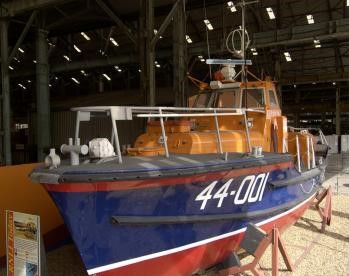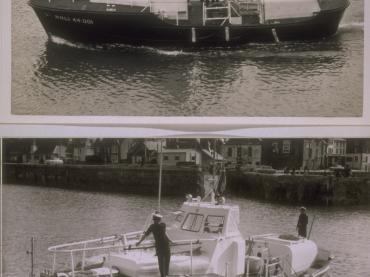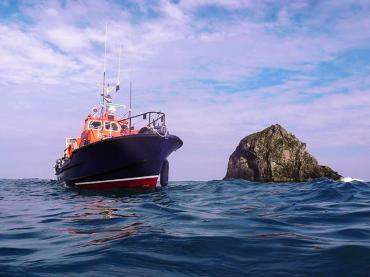


Previous names
- 1964 - 2024 44-001
Details
Construction
Dimensions
History
44-001 was built by the Coastguard Yard at Curtis Town, Maryland in 1964 with a range was 95 nautical miles, a speed of 13 knots and a crew of five. She was shipped on the SS Alaunia on 19 May 1964, arriving at Littlehampton for Press Days between 25-26 May 1964. She then moved to Appledore for service trials from 30 May 1964.
Her evaluation trials lasted some 18 months, after which it was decided by the RNLI that she could cope well with UK conditions and that further boats should be built to the same design, but incorporating certain modifications. These included extra fuel tanks, a double bottom, extended wheelhouse and raised fore-and aft cabin tops to improve the self-righting ability. These modifications were not carried out retrospectively on 44-001 which therefore differs from other members of the class.
These vessels became known as the Waveney class, with numbers 44-002 to 44-007 being built by the RNLI in 1967 and 1968 by Brooke Marine on the River Waveney in Norfolk, that river giving the class its name. Subsequent boats were built by Groves and Gutteridge (44-008 to 44-015), Bideford Shipyard (44- 016 to 44-019) and Fairey Marine (44-020 to 44-022), the last in 1982. At first, some crews were disconcerted by the relatively low initial stability, a function of the hull shape and the need for self-righting, but the general behaviour and high power which enabled the vessels to 'climb out of anything' soon endeared them to lifeboatmen and the boats were universally liked by their crews.
The first seven of the class (including 44-001) were built with two Cummins diesel engines, giving a speed of 13 knots, but the remainder were built with two GM (44-008 to 44-015), Ford Mermaid (44-016 to 44019) or Caterpillar (44-020 to 44-022) diesel engines giving a maximum speed of 16 knots. Earlier boats were since re-engined with Caterpillar diesels, although power and speed remained unchanged. The coxswain was seated in an open, but protected wheelhouse, with seats for the remainder of the crew in the cabin. Two cabins, forward and aft, had space for survivors. Due to the hull form and the exposed propellers, the Waveney operated only at stations where the lifeboat could remain afloat.
44-001 was stationed at: Solent, Barry Dock, Clovelly, Dun Laoghaire, Great Yarmouth & Gorleston, Harwich, Sheerness, Dover, Eyemouth, Whitby, Ramsgate, St Helier, Yarmouth IoW, Fowey, Alderney, Arklow. She undertook 269 (RNLI) service launches and saved 114 lives. Acting Coxswain James Dougal was awarded a Silver Medal for gallantry in 1991. She was officially un-named, but was known as 'The Yank'. She was re-engined in 1982, with repairs to split exhausts and a new gear box fitted in 1994. She was removed from service in 1996 and taken to become a display boat at Chatham Historic Dockyard. Initially she was used as an afloat exhibit, but later became a permanent static exhibit circa 2002.
Significance
- What is the vessel’s ability to demonstrate history in her physical fabric?
Evidence for designs, functions, techniques, processes, styles, customs and habits or uses and associations in relation to events and people. How early, intact or rare these features are may impact on significance.
44-001 is a 44-foot Waveney class lifeboat, the first of the RNLI classes of ‘fast lifeboat’ which originated as a design operated by the US Coastguard for general purpose inshore work. She was built with a steel hull, designed to semi-plane and an aluminium superstructure. As the first boat in her class, she is missing some of the modifications applied to later vessels post-trials, such as the extended wheelhouse and raised cabin tops. She was originally fitted with two Cummins diesel engines, giving her a speed of 13 knots, but was re-engined twice during her life, with her current Caterpillar diesels being installed in 1982. The hull is divided into seven watertight compartments including two survivor compartments and a crew space. 44-001 remains unaltered since leaving service and is therefore highly original.
- What are the vessel’s associational links for which there is no physical evidence?
Associations with people or places. Off-ship research.
44-001 was built in 1964 by the US Coastguard yard in Maryland, United States giving her international associations. However, she spent her whole life in UK service, stationed at over 20 different sites ranging from the South Coast to Kent, Yorkshire, Cornwall, the Channel Islands, Wales and Ireland. She undertook 269 RNLI service launches, saving 114 lives. Acting Coxswain James Dougal was awarded an RNLI Silver Medal in 1991 for service at night in a 100 knot hurricane and 35 foot seas to save two divers. 44-001 is nationally significant as the prototype boat which trialled the future adoption and development of a fast-afloat all-weather lifeboat. Following 44-001's successful introduction, the RNLI built 21 Waveneys of their own between 1966-82. She was recorded on the National Register of Historic Vessels in 2024.
- How does the vessel’s shape or form combine and contribute to her function?
Overall aesthetic impact of the vessel, her lines, material she was built from and her setting. Does she remain in her working environment?
The Waveney class was built with low stability and s self-righting design. 44-001 performed well with her hull lifting the vessel at speed, thus reducing drag and achieving much more than the 8 or 9 knots typical of conventional ‘displacement’ hull lifeboats of the time. She was designed with a range of 95 nautical miles, being twice the radius of action. The coxswain was seated in an open, but protected wheelhouse, with seats for the remainder of the crew in the cabin. She was fitted with two cabins, forward and aft, which had space for survivors. Due to the hull form and exposed propellers, the Waveney class was operated only at stations where the lifeboat could remain afloat. 44-001 retains her original shape and form and has been on display as a permanent static exhibit since 2002 as part of the RNLI lifeboat collection at the Historic Dockyard, Chatham.
Source: NHS-UK team, April 2024
Key dates
- 1990-10-06 RNLI Silver Medal awarded to Acting Coxswain James Dougal at Eyemouth for service at night in a 100 knot hurricane and 35 foot seas to save two divers.
Own this vessel?
If you are the owner of this vessel and would like to provide more details or updated information, please contact info@nationalhistoricships.org.uk



